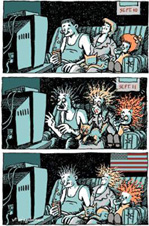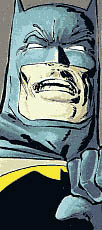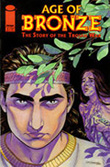OldSpeak
Below the Radar Why Graphic Novels are Worth Embracing
By Neal Shaffer
December 29, 2004
Odd as it may seem in an age dominated by media, there is a decades-old art form that remains below the radar—a form that combines the visual appeal of film, photography and illustration with the considered storytelling of novels and short stories; a form that is accessible, wide-ranging and entertaining. And you’re missing out on it.
 |
|
In the Shadow of No Towers, Art Spiegelman
|
“It” is comics. Not just the strips you see every day in the newspaper, but bona fide books (also often called graphic novels). They’ve been part of the popular landscape since at least the 1930s, when the first bound collections of newspaper strips started to appear. For almost as long, however, they’ve also been a footnote. Outside of the fact that you know them when you see them, comics remain, insofar as the whole of popular culture is concerned, undefined. As such, they occupy a unique position. They are books, but they have pictures. The pictures aren’t of things that hang in galleries, so they aren’t “art” books. But they are driven by illustration, so they can’t possibly be considered as serious as their staid, older siblings. Maybe they’re just books for people who don’t like to read?
Not at all, but the comics industry has done a poor job of making clear just exactly what they are. Recently, a string of big-budget Hollywood adaptations of mainstream superhero books has brought impressive amounts of mainstream attention to comics. As a whole, however, they are no better for it. Even though films like American Splendor (based on the life and work of legendary comics creator Harvey Pekar) and Ghost World (based on the Daniel Clowes book of the same name) have shown the more erudite side of comics, their limited reach is no match for the action flicks.
What’s left is something of a paradox, with comics largely still considered more a genre than a form. In much the same way that graphic design has had to fight its way to respectability as an art form, comics struggle for acceptance.
 |
It’s a strange fight because comics have always been a unique art form, within which one can find a full spectrum of quality. Superhero stories can certainly be done well (prime examples include Frank Miller’s The Dark Night Returns and Alan Moore’s Watchmen), but they are just one subset of the whole. Comics accommodate drama, comedy, horror, romance—and everything in between—and do so in a uniquely satisfying way.
What’s more, the appeal of comics goes beyond just story. As the recently completed election cycle proved, words are becoming increasingly cheap. The publishing industry, in particular, operates on a “win now” principle that places a premium on immediacy at the expense of perspective. The comics medium, by contrast, demands economy and thought, and it affords an opportunity to reach truth through distillation.
The content is also looking better than ever, as recent years have seen substantial strides in terms of the production values. Gone are the days of thirty- five cent throwaways for kids, with single issues now printed on higher quality paper and costing about three dollars on average. Even more significant than that is the fact that the industry is increasingly moving to the standard book format, resulting in an affordable and durable product with more permanence than the single issue format.
 |
Nevertheless, there are still only a few creators who have ever managed to make real inroads. One is Art Spiegelman, who won a Pulitzer Prize for Maus, his two volume chronicle of Holocaust survival. He also recently released In the Shadow of No Towers, an autobiographical account of dealing with the Sept. 11 attacks that has received considerable, if mixed, attention. There is also the afore-mentioned Frank Miller, whose work on books like Sin City has earned him consideration among the best of American noir. And there’s Neil Gaiman, whose “Sandman” comic series shows enduring influence. However, for every book that does get the recognition it deserves, there are countless others that do not.
Eric Shanower, for example, is at work on an ongoing series called Age of Bronze, an account of the Trojan War that has received praise for its comprehensive accuracy from Archaeology magazine. Mike Allred is producing The Golden Plates, a graphic retelling of the Book of Mormon. Seth (one name only) recently released Bannock, Beans and Black Tea and Clyde Fans, two books that stand toe to toe with the finest works of literature ever to address the complexities of the human condition. And there are folks like Adrian Tomine, Craig Thompson, Chris Ware and Antony Johnston—just a small sampling of the many creators whose work would be, if it took a form other than comics, considered with the best.
In the hands of skilled writers and artists, comics tell stories with an impact matched by no other form. They do not move like film, thus allowing the reader/viewer to linger on the details and subtleties. And the good ones do not bombard or lull you with content in the manner of prose (in those cases that do, they have failed). They are uniquely suited to bridge the gap created by an evermore instantaneous, digital culture. Their visual nature is immediate and satisfying, yet they offer the almost quaint luxuries and rewards of repeated readings.
At a time when much of the publishing industry is corrupt and agenda-driven and when so much of what it puts out is ephemeral by design, comics remain a fertile ground for true artists to do outstanding work on their own terms. It may, in fairness, take a leap of faith to embrace them, but it’s worth it.
In addition to his work for oldSpeak, Neal Shaffer is the author of three graphic novels for Oni Press.
DISCLAIMER: THE VIEWS AND OPINIONS EXPRESSED IN OLDSPEAK ARE NOT NECESSARILY THOSE OF THE RUTHERFORD INSTITUTE.


